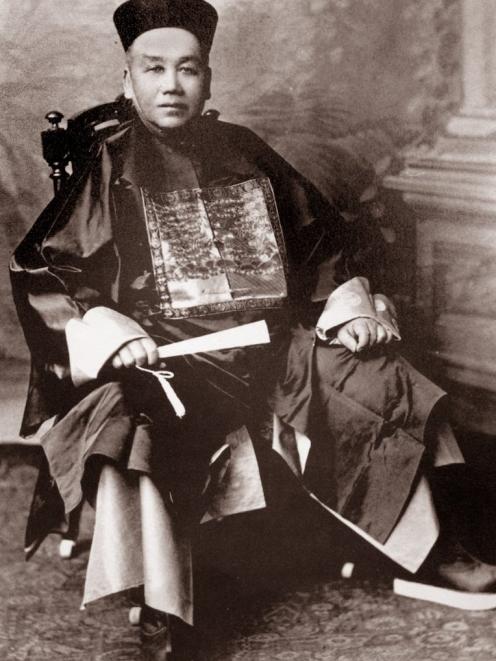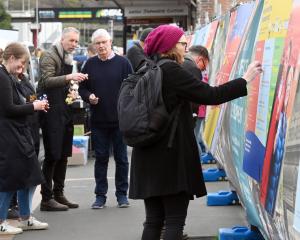Choie Sew Hoy was one of Otago’s most prominent entrepreneurs. Raised in Guandong, China, Sew Hoy came to Dunedin in 1869, via the California and Victoria goldfields.

A visionary, he revolutionised gold dredging, exported scrap metal, glass and fungus to China and imported sought-after Chinese goods. Charming and confident, Sew Hoy was a member of the Chamber of Commerce, the Jockey Club, the Freemasons and the Caledonian Society. He supported many social causes, fought racism and helped fellow Chinese migrants.
A comprehensive new biography, Merchant, Miner, Mandarin: The Life and Times of the Remarkable Choie Sew Hoy, has been co-written by descendant Jenny Sew Hoy Agnew and her husband Trevor Agnew.
The following extract details the crucial early Dunedin commercial dealings of the man who would become one of 19th century New Zealand’s most distinguished business identities.
The opening of a new Chinese enterprise is always symbolised by the putting up of a sign.
Choie Sew Hoy was a careful man, and he considered the wording for the sign above his new store’s entrance. Chinese put their family surnames first; Europeans, last. In Australia, Choie Sew Hoy had soon become used to being addressed as Mr Sew Hoy, and this was the name he normally used in his business dealings with non-Chinese. His store signboard had "Choie Sew Hoy" in Chinese characters but simply "Sew Hoy" in English. Around the world, his descendants use either Choie (Tsui, Chui, Xu) or Sew Hoy as their surname, but they all know who their ancestor is.
The first group of customers for the Sew Hoy store arrived a few days later, when the Tararua berthed at Port Chalmers with 196 Chinese steerage passengers, the rest of the Lyttelton miners. Many, if not all, of these men would have been from Sew Hoy’s native Poon Yu County and the other Sam Yup counties. They made an immediate impression.
"Stafford-Street, Dunedin, was very busy one day last week, at Messrs Reid and Herberts, in consequence of the departure for the Tuapeka Goldfield of about 110 Chinese", wrote the Dunedin correspondent of the Naseby newspaper. Reid and Herbert, who operated a delivery and forwarding business, were able to arrange wagons and drivers, and their firm was popular with the Chinese. Reid’s office premises were at what is now No. 13, just across the road from the Sew Hoy store. The wagons were brought down from the stables further up Stafford Street, which made it easy for the miners to load up their equipment and food supplies.

Two days after landing, the Tararua men were impressing the citizens of Tokomairiro (Milton) on their way to Lawrence. "On Thursday afternoon [April 22 1869] two six-horse waggons [sic] passed through our town, heavily laden with Chinese, their stores, swags &c., on their way to Tuapeka. Throughout the day considerable numbers also passed on foot, and who attracted the attention of the small boys, as they struggled along bare-footed under the apparently heavy loads of baggage they carried along with them."

"Old metal" soon became a regular export from Otago, and Sew Hoy eventually had to take a yard near the wharves to store his bags of worn-out horseshoes. Nor was he the only merchant to export scrap metal. Advertisements by Chinese merchants for scrap copper, iron, zinc and lead appeared throughout the 19th century. They had found there was also a market for glass. The scrap metal trade did have its risks. When the unfortunate merchant Mee Wah, "a very quiet and harmless man", was sent to prison for three months in 1877, his offence was buying lead piping from men who had stolen it from a Dunedin Council work site.
There could be problems with pilfering. In 1880 a nine-year-old boy was prosecuted for stealing "a bagful of old iron horseshoes ... being the property of Sew Hoy, and being of the value of 6d". He was sent to the industrial school for six years. As the police inspector told the court, probably no charge would have been laid if the boy’s father had taken any steps in the matter.
"But, nothing being done, Mr Sew Hoy was forced to take proceedings, as he suffered largely from small pilfering of the kind."
Choie Sew Hoy had not only spotted a use for scrap metal; he had also found a way to turn bones into money. When the Minnie Graham sailed back to Hong Kong from Otago in June 1871 she carried 116 returning Cantonese miners and their 4234 ounces of gold. Under her hatches was a load of "iron and bones ... a considerable amount of old metals". Canton’s carvers could produce handsome carvings from beef bones, while shin bones were used to make mah jong sets for people who could not afford ivory.

Sew Hoy purchased a wool press and set it up in the store, beside the scales. The men could place the sacking inside the press, fill it with the appropriate amount of fungus, and then pack the contents down tight, before sewing up the bale, ready for export. In February 1882, the Reverend Alexander Don, a Presbyterian minister then at the beginning of his mission to the Chinese in New Zealand, popped in to wish Sew Hoy the compliments of the Chinese New Year, and leave his visiting card, which was added to hundreds stuck to the wall. Don was impressed to see "eight workmen weighing bales of muk yee from Wellington". Nor did Sew Hoy simply wait on supplies to arrive from Taranaki; he advertised for fungus in such likely areas as Nelson and Whanganui.

In the early 1880s, William Blair, a leading public works engineer, who had paused from overseeing railway construction in Otago and Southland to write an account of New Zealand's industries, asked Sew Hoy what the dried fungus was used for and was relieved to learn that "it was used in soups as ordinary food; but Mr Sew Hoy informs me that it is chiefly used as a dye. The exports during the past ten years [1872 to 1882] have grown from £1,927 to £18,939". Blair described fungus gathering as a vagabond industry but it was a profitable one, both for the hard-pressed farmers and their families who did the gathering, and for the Chinese merchants who marketed it. Between 1872 and 1941, New Zealand exported about 25,000,000 kilograms of fungus, with a sterling value of over £643,000.

Sew Hoy told how, in July 1870, he had received a letter from See Long, ordering 15 pounds (6.8 kilograms) of opium. Sew Hoy took the package down to the Cobb & Co. booking office at the corner of Stafford and Princes streets and paid 15s for it to be delivered to the Naseby coach office, which was located in the Royal Hotel, still standing in Earne Street. See Long’s evidence was that when he went to the office after the coach had arrived, the agent told him there had been no parcel for him. The reporting of Sew Hoy’s evidence suggests that when he heard of this "he then went up the country in search of it, but had not got it". Sew Hoy did, however, still have the memorandum (or receipt) from Cobb & Co. This gave See Long the evidence he needed to make a claim for the value of the opium in Naseby, which was £51.
Sew Hoy’s ever-fertile mind was always looking for clever ways of expanding his range of stock and diversifying his customer base. Instead of relying solely on a small pool of Chinese customers, he decided to import Chinese-made goods that would appeal to the wider Otago population.













